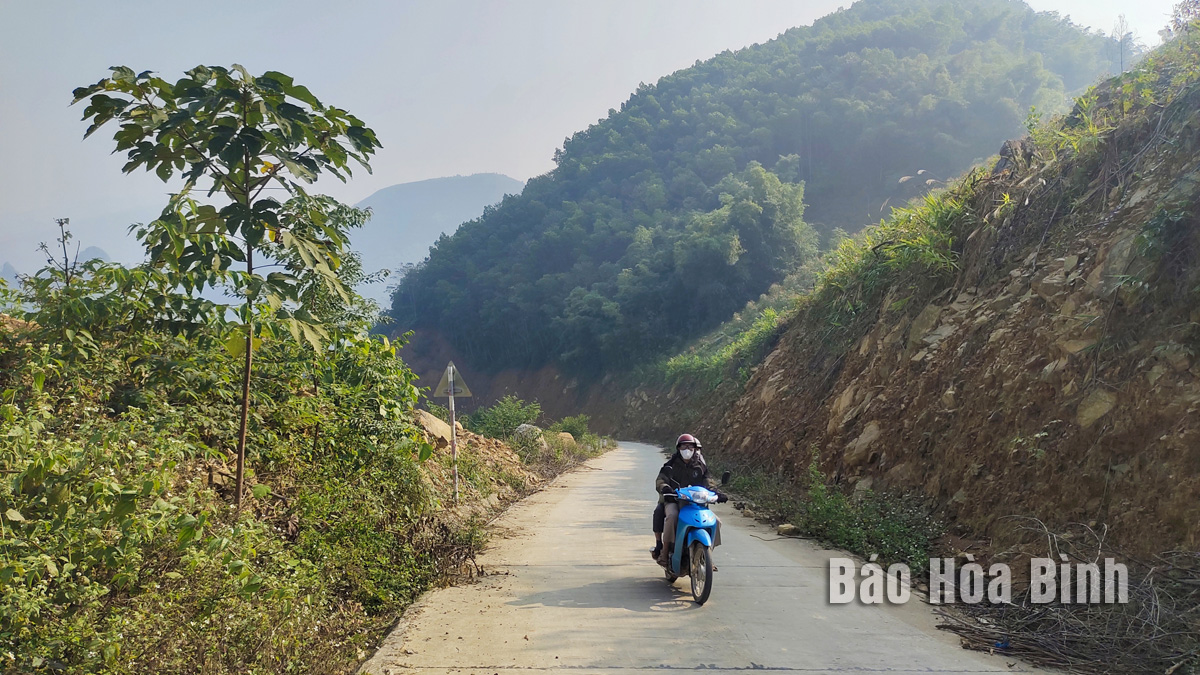
Thanks to the national target programme on new-style rural area building, the highland district of Da Bac has got a facelift and the material and spiritual lives of local residents have been improved.
A newly-built road from Tam village to Giang village in Cao Son commune.
According to a report of the Da Bac People's Committee, the district has four communes that have satisfied new-style rural building criteria. In recent years, through the new-style rural area building programme, the rural infrastructure system has been developed vigorously and the living conditions of rural residents have been improved.
Cao Son is one of the four communes in the district that has been recognised as meeting new-style rural area criteria. Coming to the commune, changes can be seen with roads being widened and concretised.
Dinh Van Lam, who resides in Giang village - one of villages that is far away from the commune centre, said in the past, people's lives faced many difficulties due to transport-related problems. Since the implementation of the new-style rural area building programme, roads in the village have been concreted, making it convenient for traders to come the village to buy agricultural products, he noted.
After the road connecting Giang village with Tam village was opened to traffic, it is easy for local residents to go to the commune centre to sell goods or make transactions at the commune People's Committee. Thanks to the road, many households have escaped poverty, and some even have been able to buy cars.
According to Ngo Van Cuong, Secretary of the Cao Son Commune Party Committee, to fulfil the criteria for new-style rural area building, in addition to the State's investment resources, it is necessary for people in the commune to enthusiastically respond to the movement.
Total capital mobilised to serve the commune's new-style rural area building programme for the 2010-2020 period was over 359 billion VND (14.6 million USD). Of which, local residents donated money, land and working days worth over 34 billion VND, Cuong said.
Cao Son is striving to meet standards for an advanced new-style rural area, he said, elaborating that 7 out of the 19 criteria have been fulfilled.
Bui Khac Vinh, Head of the district’s Division of Agriculture and Rural Development, said in 2023, four communes met 19 out of the 19 criteria, one fulfiled 15 out of the 19 criteria and 11 communes satisfied between 10-13 criteria. It also had three more products that were rated as three-star products under the One Commune One Product (OCOP) programme in 2023, raising the number of OCOP products to nine.
The district now has five model residential areas and 17 model gardens.
The official said the district has set specific goals for new-style rural areas building in 2024. They include improving the material and spiritual lives of local residents, linking agricultural development with industry and services as well as rural development with urban areas.
The district also rolled out solutions to achieve the goals which priotise fund for supporting the development of cooperative economic models and production linkage models in line with value chains to generate jobs and increase incomes for rural residents.
The communication work will be stepped up to mobilise the entire political system to join hands in building new-style rural areas, he said, adding that attention will be paid to implementing a number of criteria, especially those related to transport infrastructure, irrigation, schools, health stations, clean water, and the environment.
The Standing Board of the Hoa Binh provincial Party Committee met on March 18 to review and guide major investment projects aimed at boosting local socio-economic development.
The air is thick with the hum of drills and the clatter of machinery as the Hoa Binh – Moc Chau expressway takes shape amid the rugged terrain. Welding sparks illuminate the faces of workers, and concrete mixers churn relentlessly, laying fresh pavement on the newly-carved road. The construction site buzzes with a palpable sense of urgency, particularly in Hoa Binh province where the expressway's future is being forged.
The northern province of Hoa Binh, with over 467,000 hectares of natural forest and more than 100,000 hectares of production forest, holds significant potential for carbon credit market development.
Replacing substandard houses with more sturdy ones by June 30 is the direction given by Nguyen Phi Long, alternate member of the Party Central Committee and Secretary of the Hoa Binh provincial Party Committee, at a meeting held in early March by the provincial Steering Committee for the programme to eliminate temporary and dilapidated houses for the needy.
Recognising digital transformation as an inevitable trend, authorities and agencies in Hoa Binh have made great efforts in the work by focusing on three core pillars - digital government, digital society, and digital economy, resulting in enhanced competitiveness, improved investment climate, and ensured economic and social welfare.
In recent years, Da Bac district has improved administrative reform with a one-stop shop mechanism, streamlined inter-agency procedures, and a shift to digital platforms. These efforts have enhanced public service efficiency and contributed to local socio-economic development.



